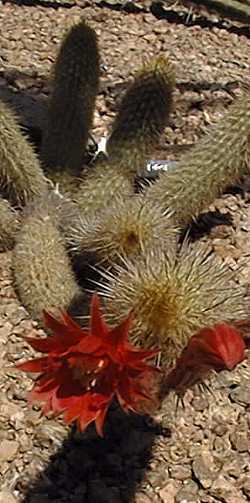Cleistocactus acanthurus
Scientific Name: Cleistocactus acanthurus (Vaupel) D.R. Hunt
Synonym: Binghamia acanthura, Binghamia eriotricha, Borzicactus acanthurus, Borzicactus eriotrichus, Borzicactus keller-badensis, Cereus acanthurus, Cereus eriotrichus, Cleistocactus acanthurus ssp. pullatus , Haageocereus paradoxus, Loxanthocereus bicolor, Loxanthocereus canetensis, Loxanthocereus convergens, Loxanthocereus cullimannianus, Loxanthocereus eremiticus, Loxanthocereus erigens, Loxanthocereus gracilispinus, Loxanthocereus jajoianus, Loxanthocereus keller-badensis, Loxanthocereus multifloccosus, Loxanthocereus neglectus, Loxanthocereus pacaranensis, Loxanthocereus pullatus, Seticereus acanthurus, Seticereus eriotrichus
Family: Cactaceae
USDA: 9-10
Frost Tolerance: Hardy in Phoenix
Sun Exposure: light shade
Origin: Peru
Growth Habits: Basally clumping, stems up to 3 feet long (90 cm), 1 to 4 inches (2.5 to 10 cm) in diameter; 17 to 18 ribs; 1 to 5( up to 20) central spines, 0.4 to 1 inch (2 to 2.5 cm) long; 20( to 30) radial spines, 0.1 to 0.3 (0.3 to 0.8 cm) long;
Watering Needs: Water generously during the summer.
Propagation: Cuttings
The species name "acanthurus" comes from the Greek for "with spines".
Blooming Habits:
The column flowers blossom freely in cultivation (the picture was taken mid-April in Phoenix). The red flowers are up to 1.6 to 3.2 inches long (4 to 8 cm), 0.8 inch (2 cm) in diameter, followed by red spiny fruits 0.5 inch long (1.2 cm)
Desert-Tropicals is dedicated to provide gardening advice, gardening ideas, and information about flower of all kind for landscape and collections.We try to check carefully the identification of the plants on the illustrations as well as the other information from the page, but occasionally errors do occur. if you notice anything that needs to be changed please contact us.Thanks.
© 1998-2020 Philippe Faucon, All Rights Reserved.
